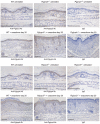Differential effects of peptidoglycan recognition proteins on experimental atopic and contact dermatitis mediated by Treg and Th17 cells
- PMID: 21949809
- PMCID: PMC3174980
- DOI: 10.1371/journal.pone.0024961
Differential effects of peptidoglycan recognition proteins on experimental atopic and contact dermatitis mediated by Treg and Th17 cells
Abstract
Skin protects the body from the environment and is an important component of the innate and adaptive immune systems. Atopic dermatitis and contact dermatitis are among the most frequent inflammatory skin diseases and are both determined by multigenic predisposition, environmental factors, and aberrant immune response. Peptidoglycan Recognition Proteins (Pglyrps) are expressed in the skin and we report here that they modulate sensitivity to experimentally-induced atopic dermatitis and contact dermatitis. Pglyrp3(-/-) and Pglyrp4(-/-) mice (but not Pglyrp2(-/-) mice) develop more severe oxazolone-induced atopic dermatitis than wild type (WT) mice. The common mechanism underlying this increased sensitivity of Pglyrp3(-/-) and Pglyrp4(-/-) mice to atopic dermatitis is reduced recruitment of Treg cells to the skin and enhanced production and activation Th17 cells in Pglyrp3(-/-) and Pglyrp4(-/-) mice, which results in more severe inflammation and keratinocyte proliferation. This mechanism is supported by decreased inflammation in Pglyrp3(-/-) mice following in vivo induction of Treg cells by vitamin D or after neutralization of IL-17. By contrast, Pglyrp1(-/-) mice develop less severe oxazolone-induced atopic dermatitis and also oxazolone-induced contact dermatitis than WT mice. Thus, Pglyrp3 and Pglyrp4 limit over-activation of Th17 cells by promoting accumulation of Treg cells at the site of chronic inflammation, which protects the skin from exaggerated inflammatory response to cell activators and allergens, whereas Pglyrp1 has an opposite pro-inflammatory effect in the skin.
Conflict of interest statement
Figures










Similar articles
-
Peptidoglycan recognition protein Pglyrp2 protects mice from psoriasis-like skin inflammation by promoting regulatory T cells and limiting Th17 responses.J Immunol. 2011 Dec 1;187(11):5813-23. doi: 10.4049/jimmunol.1101068. Epub 2011 Nov 2. J Immunol. 2011. PMID: 22048773 Free PMC article.
-
The role of interleukin-17 in mouse models of atopic dermatitis and contact dermatitis.Clin Exp Dermatol. 2015 Aug;40(6):665-71. doi: 10.1111/ced.12567. Epub 2015 Feb 16. Clin Exp Dermatol. 2015. PMID: 25684357
-
Role of YAP-related T cell imbalance and epidermal keratinocyte dysfunction in the pathogenesis of atopic dermatitis.J Dermatol Sci. 2021 Mar;101(3):164-173. doi: 10.1016/j.jdermsci.2020.12.004. Epub 2020 Dec 18. J Dermatol Sci. 2021. PMID: 33358580
-
Role of Th17 in the pathogenesis of cutaneous inflammatory diseases.J Biol Regul Homeost Agents. 2012 Jul-Sep;26(3):313-8. J Biol Regul Homeost Agents. 2012. PMID: 23034250 Review.
-
Review: Mammalian peptidoglycan recognition proteins (PGRPs) in innate immunity.Innate Immun. 2010 Jun;16(3):168-74. doi: 10.1177/1753425910366059. Epub 2010 Apr 23. Innate Immun. 2010. PMID: 20418257 Review.
Cited by
-
Peptidoglycan Recognition Protein 4 Suppresses Early Inflammatory Responses to Bordetella pertussis and Contributes to Sphingosine-1-Phosphate Receptor Agonist-Mediated Disease Attenuation.Infect Immun. 2019 Jan 24;87(2):e00601-18. doi: 10.1128/IAI.00601-18. Print 2019 Feb. Infect Immun. 2019. PMID: 30510103 Free PMC article.
-
The Effect of Single CpG Demethylation on the Pattern of DNA-Protein Binding.Int J Mol Sci. 2019 Feb 20;20(4):914. doi: 10.3390/ijms20040914. Int J Mol Sci. 2019. PMID: 30791552 Free PMC article.
-
Peptidoglycan Recognition Protein 2 Regulates Neutrophil Recruitment Into the Lungs After Streptococcus pneumoniae Infection.Front Microbiol. 2019 Feb 19;10:199. doi: 10.3389/fmicb.2019.00199. eCollection 2019. Front Microbiol. 2019. PMID: 30837960 Free PMC article.
-
Peptidoglycan recognition protein 3 and Nod2 synergistically protect mice from dextran sodium sulfate-induced colitis.J Immunol. 2014 Sep 15;193(6):3055-69. doi: 10.4049/jimmunol.1301548. Epub 2014 Aug 11. J Immunol. 2014. PMID: 25114103 Free PMC article.
-
Role of Th17 cells in skin inflammation of allergic contact dermatitis.Clin Dev Immunol. 2013;2013:261037. doi: 10.1155/2013/261037. Epub 2013 Aug 18. Clin Dev Immunol. 2013. PMID: 24023564 Free PMC article. Review.
References
-
- De Benedetto A, Agnihothri R, McGirt LY, Bankova LG, Beck LA. Atopic dermatitis: a disease caused by innate immune defects? J Invest Dermatol. 2009;129:14–30. - PubMed
-
- Fonacier LS, Dreskin SC, Leung DY. Allergic skin diseases. J Allergy Clin Immunol. 2010;125(Suppl 2):S138–149. - PubMed
-
- Wang B, Feliciani C, Freed I, Cai Q, Sauder DN. Insights into molecular mechanisms of contact hypersensitivity gained from gene knockout studies. J Leukoc Biol. 2001;70:185–191. - PubMed
-
- Martin SF, Jakob T. From innate to adaptive immune responses in contact hypersensitivity. Curr Opin Allergy Clin Immunol. 2008;8:289–293. - PubMed
Publication types
MeSH terms
Substances
Grants and funding
LinkOut - more resources
Full Text Sources
Molecular Biology Databases
Miscellaneous

